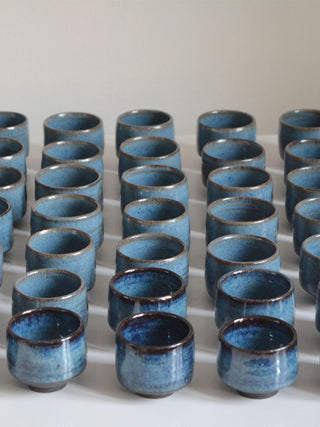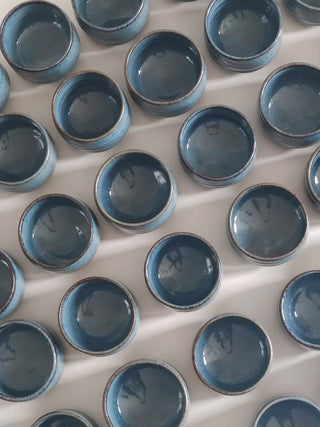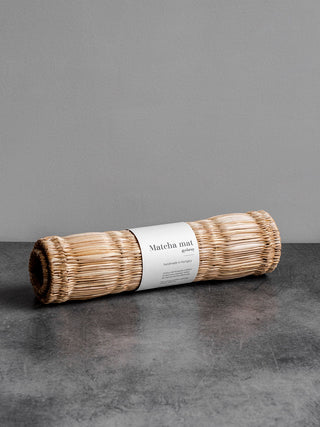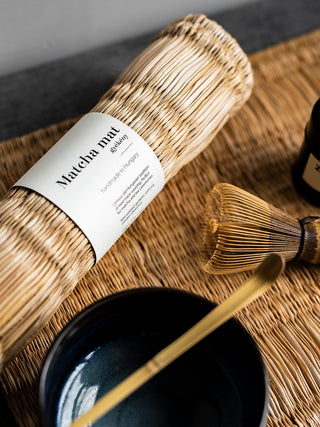In the past few months, we have been experimenting with our matcha tea as well as our matcha accessories. As a result, we have just received a set of beautiful azure-glazed chawans from Tünde Ruzicska’s workshop along with our KEZEMURA pieces. Besides, we decided to indulge ourselves in the world of chasens as well.
Chasen (茶筅, tea whisk) is one of the key accessories in matcha preparation and as such, it is vital to have the right kind and quality to make good matcha. There are numerous types of chasens with many small differences in material, preparation, shapes, and usage, however, there is one universal law that applies to all chasens, namely that they are always made of a single piece of bamboo.
 Sen no Rikyū (1522 – 1591), Japanese Buddhist monk and tea master
Sen no Rikyū (1522 – 1591), Japanese Buddhist monk and tea master
The History of Chasen
The history and development of chasens are closely tied to that of Wabi Cha (侘茶) a certain branch of Chadō (茶道, or Cha no Yu, 茶の湯) that was accomplished by a Buddhist monk, called Sen no Rikyū (千利休). Wabi-cha sought to give an alternative to the elite tradition of Chanoyu. It emphasized rustic simplicity and supported local potters. One of the new wave styles that appeared in this era is the famous Raku ware (楽焼) that, ironically, is one of the most expensive Japanese ware types today.
Since matcha has always been regarded as the high-peak of Japanese tea ceremony, the development of the ceremony inevitably brought the development of chasens. There are three big schools that follow the path that Rikyū appointed: Omotesenke (表千家), Urasenke (裏千家), and Mushakōjisenke (武者小路千家). Each of these has a distinct style, ceremony, and choice of accessories—such as chasens—as well as their own lineage going back to Rikyū himself.



 Classic kazuho and formal shin style Shichiku chasens
Classic kazuho and formal shin style Shichiku chasens
Making and types of Chasen
One of the most important and significant features of chasens is the type of bamboo they are made of. Here are a few of the many subspecies:
- Aodake (青竹), a fresh green bamboo used for New Year ceremonies
- Hachiku (淡竹), sun-dried white bamboo, a characteristic of the Urasenke School
- Kanetake (金竹), or golden bamboo used for everyday chasens
- Kurotake (黒竹), a black-colored bamboo preferred by the Mushanokojisenke school
- Shichiku (紫竹), or purple bamboo a variety of Kurotake.
The bamboo used for chasens is usually about three years old and is harvested in winter. After the harvest, the bamboo is dried for a year. First, during the winter, it is done outside letting the winter weather season the sticks, then it is put in dry storage and left there for the rest of the year.
Once the bamboo is ready the suitable ones are selected by the master. Then, they are cut into 9-12 cm long pieces and hand-carved into almost ready chasens by the apprentices. At the end of the process, the chasens are handed back to the master for fine-tuning which consists of curving and threading.
The final shape of the chasens is determined by myriad different factors, like school, purpose, and occasion, or the type of bamboo it is made of. The two basic types of chasen are Chu-araho with 70 to 80 rougher bristles used for koicha (濃茶, or thick matcha) and Kazuho with up to 120 finer bristles used mainly for usucha (薄茶, or thin matcha). Besides these two, there are various kinds of other chasens for special occasions. For example, for outdoor gatherings, Nodate (野点) is the best choice. Tenmoku (天目) tea bowls require Tenmoku chasens, and Kotobuki (寿) chasens are reserved exclusively for the New Year.
 Shichiku chasen on a ceramic stand
Shichiku chasen on a ceramic stand
Care
Although chasens are not meant to last forever, with the right cleansing method its lifespan can be prolonged. Before usage, the chasen must be soaked in warm water (not hot, as it would damage the bamboo) for a few minutes. The soaking will allow the bristles to unfold a bit and it also helps to improve the elasticity of the whisk.
While preparing matcha one must always pursue soft movements and should avoid touching the wall of the chawan (茶碗, tea bowl) in order to preserve the chasen’s shape and prevent bristles from breaking.
After using the chasen, first, it needs to be soaked again—sometimes even two or three times—in warm water until the remaining powder is gone. No soap or other cleansing chemicals are required. When the chasen is completely cleaned it should be properly dried before putting back into its package. The chasen must never be dried in an upright position lest excess water may collect in the handle and form mould. The best way to dry the chasen is to put it on a chasen stand so that it can regain its original shape. The cleaning of the chasen after usage is just as important as the initial soaking.
Curiosity
In addition to these new ideas regarding the different types of chasens we also experimented with the water we use for making matcha. The best water we found was so-called reverse osmosis water. This type of water is a demineralized one that contains less than 1% of the minerals originally found in water. Due to this change, the matcha gets much smoother and has thicker foam.
 Zhao Zhou matcha set with azure-glazed Ruzicska chawan and Shichiku chasen
Zhao Zhou matcha set with azure-glazed Ruzicska chawan and Shichiku chasen















